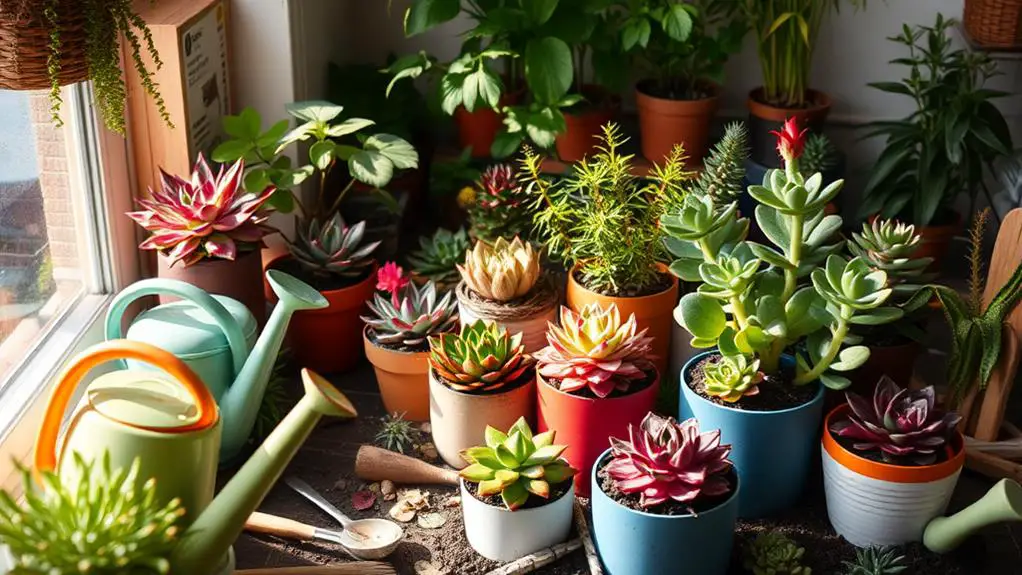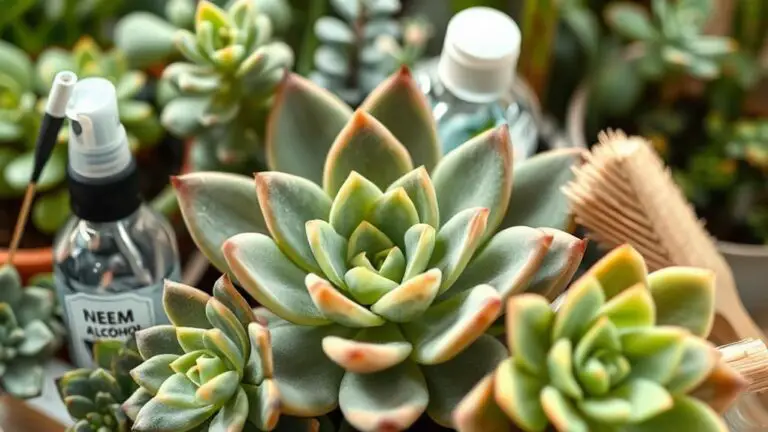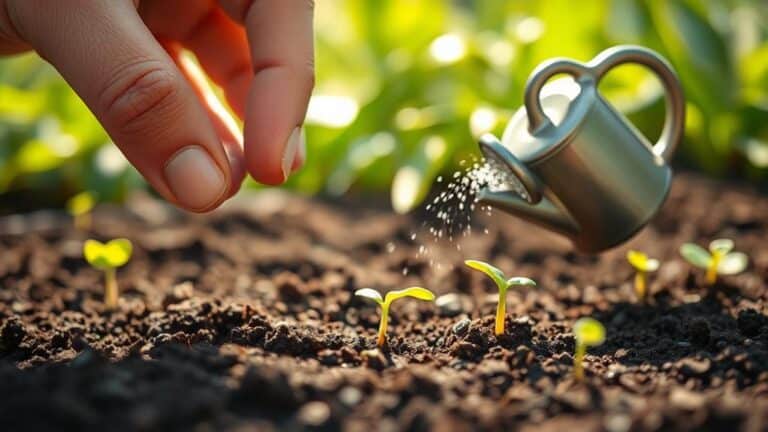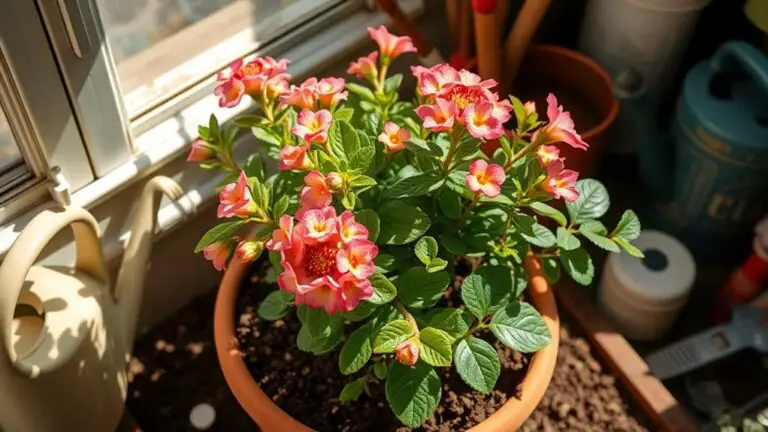Grow Succulents and Save Water – A How-To Guide
You're considering growing succulents not just for their beauty but also to conserve water. Start by selecting the right soil and containers; these choices are vital for avoiding overwatering, which is a common mistake. Opt for resilient varieties like Aloe Vera or Echeveria, and make sure they get plenty of indirect sunlight. Understanding when and how to water your succulents is key—using the "soak and dry" method can make all the difference. Ready to transform your garden into a low-maintenance, water-efficient oasis? Let's explore the essential steps and tips.
Benefits of Growing Succulents

Growing succulents offers numerous benefits that make them an excellent choice for both novice and experienced gardeners. These plants are masters at conserving water, storing it in their thick tissues. You only need to water them about once a week during the growing season. This low maintenance makes them perfect for anyone with a busy schedule.
Succulents thrive in high temperatures, with some varieties handling up to 120°F. This makes them ideal for drought-prone areas. By incorporating succulents into your landscaping, you can greatly reduce the amount of water needed for your garden. This not only helps you save water but also supports water conservation efforts in places like California.
Besides being water-efficient, succulents come in a wide array of colors, shapes, and textures. They can brighten up any space and improve indoor air quality.
You can also easily propagate succulents, meaning you can grow new plants from cuttings. This reduces the cost of your gardening and supports local biodiversity.
Environmental Impact
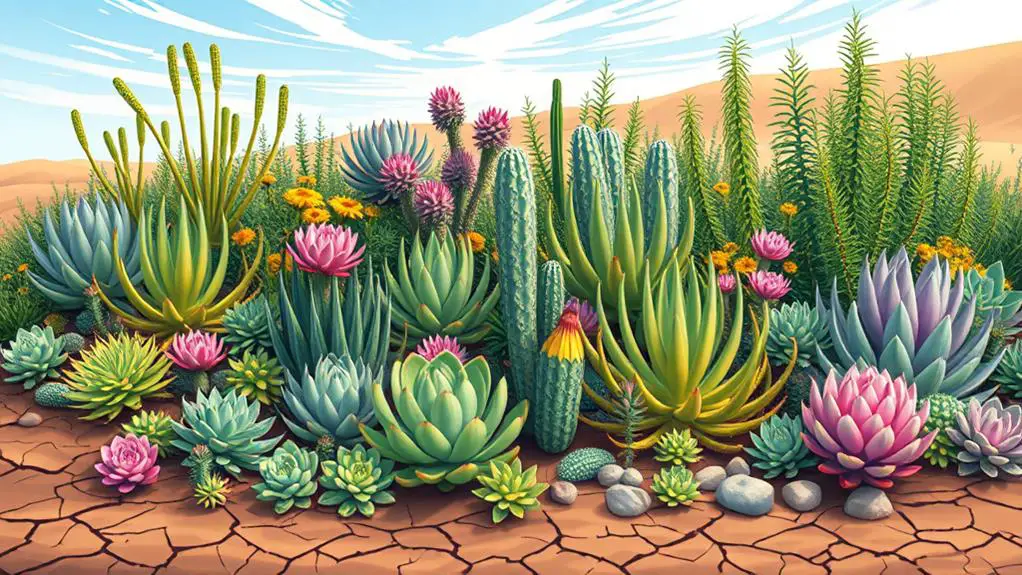
In addition to their aesthetic appeal, succulents make a considerable positive environmental impact. These plants have water-storing tissues, allowing them to thrive in arid environments with minimal water, typically needing only a weekly watering during the growing season. By incorporating succulents into your landscaping, especially in drought-affected regions like California, you can considerably reduce water consumption and help mitigate the water crisis.
Here's a quick comparison to show the benefits:
| Aspect | Succulents vs. Traditional Plants |
|---|---|
| Water Requirement | Minimal |
| Watering Frequency | Once a week |
| Biodiversity Enhancement | High |
| Suitable for Arid Regions | Yes |
| Support for Community Gardens | Strong |
Using drip irrigation systems and rainwater collection techniques, along with succulents, can further enhance water conservation efforts. These methods minimize waste and optimize water usage, making your gardening practices more sustainable.
Succulents also boost local biodiversity in urban areas and promote sustainable gardening practices. Their popularity in community gardens raises environmental awareness and encourages conservation-minded gardening. By growing succulents, you contribute to a greener, more sustainable world. Remember, every small step in water conservation counts, and your efforts in planting succulents can make a big difference.
Care and Maintenance
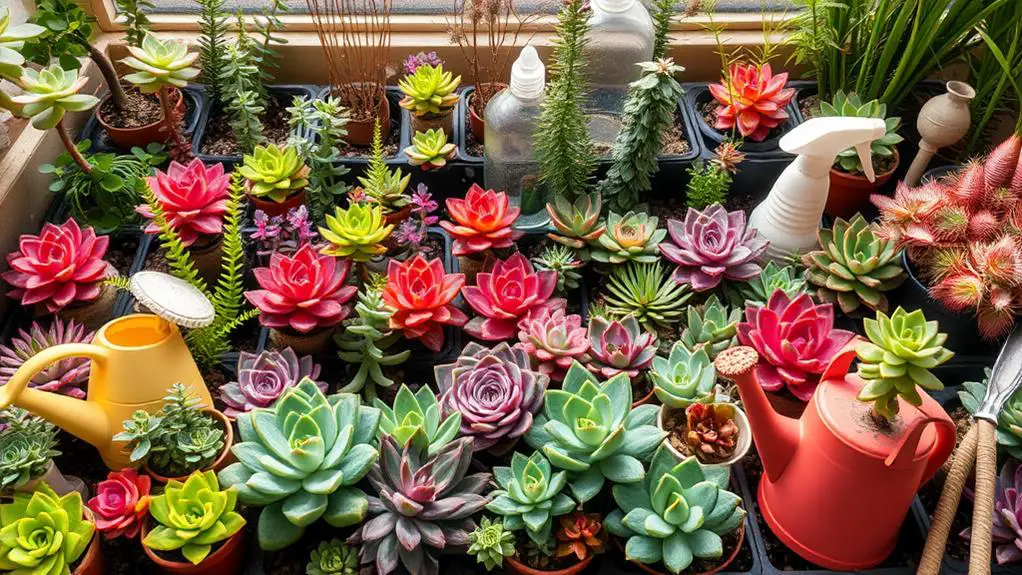
Proper care and maintenance are vital for thriving succulents. To care for succulents, start by monitoring soil moisture levels closely. Only water them when the top 1.25 inches of soil feels dry. This prevents overwatering, which is the most common cause of root rot.
Using well-draining soil is also important. Mix regular potting soil with sand, pumice, or perlite to guarantee excess water can easily escape.
During the growing season in spring and summer, fertilize your succulents sparingly. A diluted, balanced fertilizer once a month is enough. Avoid fertilizing them in the fall and winter when they're dormant.
Regular maintenance includes inspecting your succulents for pests like mealybugs and aphids. Treat any infestations promptly with insecticidal soap or neem oil to keep your plants healthy.
Rotate your succulents weekly. This encourages even growth and prevents them from leaning towards light sources, which can lead to uneven development and weaker plants.
With these simple steps, you'll make certain your succulents stay healthy and beautiful. Remember, a little attention goes a long way in keeping your succulents happy and thriving.
Common Succulent Varieties
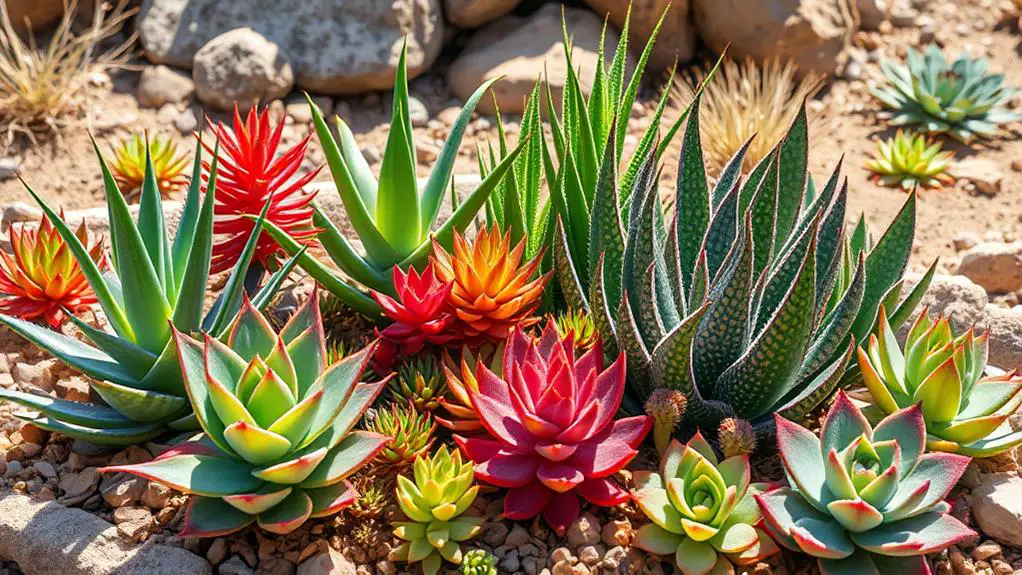
Succulents come in a variety of shapes and sizes, each with its own unique characteristics and care requirements. One popular choice is Aloe Vera, known for its easy care and medicinal properties. You can keep it both indoors and outdoors, making it versatile.
The Echeveria varieties, with their striking rosette shapes and wide range of colors, add a lot of visual appeal to any arrangement. They're perfect if you want some eye-catching indoor plants.
For those of you looking for hardy, drought-resistant options, Sedum is a fantastic choice. It thrives in poor soil conditions and is often used as ground cover.
If your home doesn't get a lot of sunlight, Haworthia is a compact succulent that tolerates low light well, making it ideal for indoor spaces.
The Jade Plant isn't only a symbol of good luck but also easy to propagate and care for. This makes it a favorite among both novice and experienced gardeners.
Its resilience and simplicity make it an excellent starter plant if you're new to succulent varieties. With these options, you can easily find a succulent that fits your needs and preferences.
Challenges and Trends
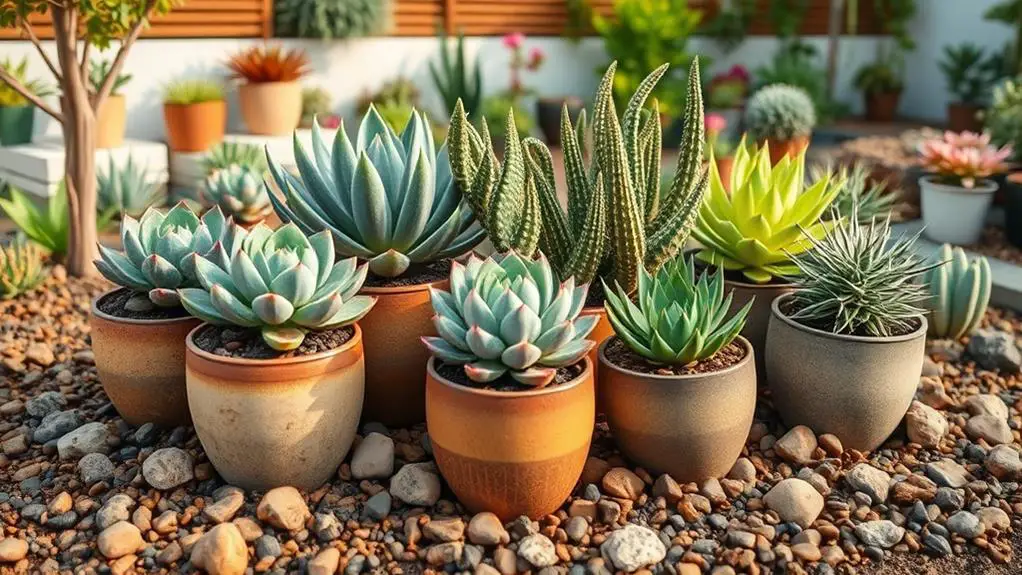
When growing succulents, you'll face challenges like overwatering and pest infestations, but you can overcome these with careful attention to watering habits and regular plant inspections.
Succulents are also becoming a popular choice for urban landscaping as they require less water, making them perfect for drought-prone areas.
Additionally, joining local workshops and events can help you learn more about succulent care while connecting with fellow enthusiasts.
Overcoming Common Issues
Many gardeners face common challenges when growing succulents, but with the right strategies, these issues can be easily overcome.
Overwatering is the top culprit, often leading to root rot. To prevent this, make sure the soil is dry before watering again.
Pest infestations, especially from mealybugs and aphids, can be tackled by regularly inspecting your plants and using insecticidal soap or neem oil when you spot a problem.
Insufficient light can cause your succulents to stretch or become leggy. If you notice this, consider moving them to a brighter spot or using a grow light to give them the light they need.
Seasonal temperature changes can also stress your succulents. Aim to keep them in a stable environment between 60°F and 80°F (15°C – 27°C) to protect them from frost and extreme heat.
Succulents are increasingly popular in drought-affected areas because they're perfect for sustainable landscaping and help reduce water consumption.
By understanding these common issues and knowing how to address them, you'll find that growing succulents can be both enjoyable and rewarding.
Stick with it, and your succulents will thrive!
Popularity in Urban Landscaping
Why have succulents become a cornerstone of urban landscaping? It's simple: they're drought-resistant and perfect for areas where water conservation is essential, like California. Urban landscaping with succulents not only saves water but also promotes eco-friendly living. These plants are a great way to make your garden look beautiful without wasting resources.
Urban communities are embracing succulents by hosting workshops and supporting local businesses that sell them. These events spread awareness about sustainable gardening and encourage you to adopt drought-resistant landscaping. Plus, succulent gardens stand as a statement against water waste, creating visually appealing and eco-friendly spaces.
However, urban landscaping with succulents isn't without its challenges. You'll need to manage pests and guarantee your plants get enough light, especially in densely populated areas. Luckily, there are innovative gardening solutions to help you overcome these hurdles.
The rise of subscription services is another exciting trend. These services make it easy for you to access a variety of succulents for your landscaping projects. They provide a convenient way to keep your garden fresh and interesting.
| Benefit | Challenge |
|---|---|
| Drought-resistant | Pest management |
| Water conservation | Guaranteeing enough light |
| Eco-friendly spaces | Dense urban areas |
| Subscription services | Innovative solutions |
With these tips and trends, you'll find that growing succulents is both rewarding and sustainable.
Light Requirements
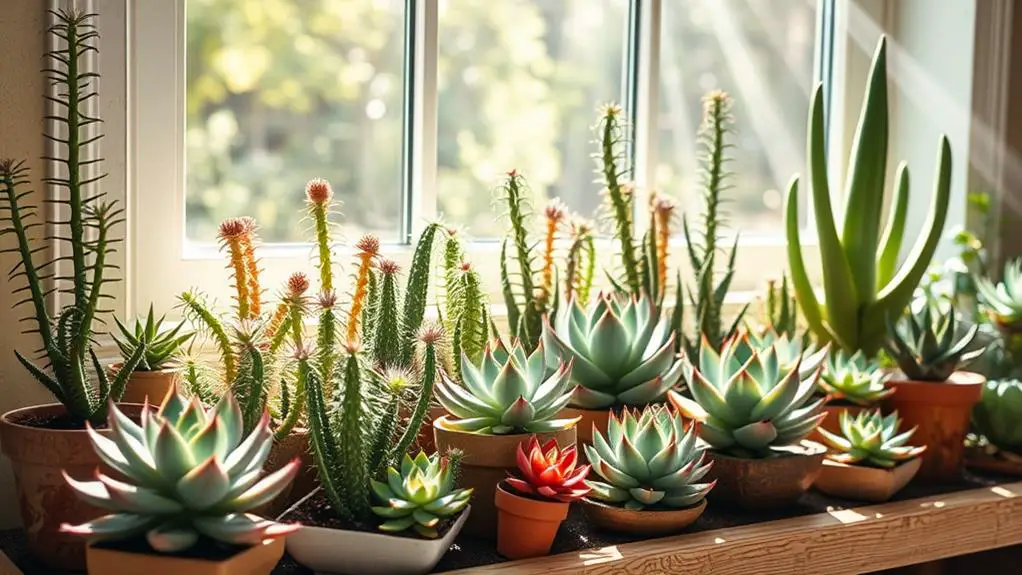
To help your succulents thrive, aim to give them around six hours of sunlight each day, but be careful with direct sunlight to avoid leaf burn.
Bright, indirect light is usually best, and you can use sheer curtains to filter strong rays.
Remember to rotate your succulents weekly so they grow evenly and don't lean too much toward the light source.
Ideal Sunlight Duration
Understanding the ideal sunlight duration for your succulents is crucial for their health and growth. Typically, succulents need about six hours of sunlight daily. They thrive in bright, indirect sunlight, though some can handle direct sunlight in small doses. Be certain to place your succulent pots in a spot where they get ample light but aren't scorched. If your plants start leaning or stretching, it's a sign they need more light, and you might need to use grow lights.
To help your succulents grow evenly, rotate the pots weekly. This guarantees that all sides get equal light, promoting overall plant health. Grouping your succulents together can also create a helpful microclimate, boosting light exposure and humidity.
Here's a quick guide to help you understand their light needs better:
| Lighting Type | Description |
|---|---|
| Direct Sunlight | Only in small doses to avoid sunburn. |
| Bright Indirect Sunlight | Ideal for most succulents. |
| Grow Lights | Useful if natural light is insufficient. |
| Rotating Pots | Helps in even growth by weekly rotation. |
| Grouping Together | Enhances light exposure and humidity. |
Preventing Light Burn
Preventing light burn in succulents guarantees they stay healthy and vibrant. Succulent plants typically need around six hours of sunlight each day. However, too much direct sunlight can cause light burn, damaging their leaves.
To avoid this, make sure your plants get bright indirect sunlight. Sheer curtains can help filter harsh rays while still providing adequate light exposure.
Rotating your succulents weekly is another effective way to protect them. By doing this, you make sure even light distribution, preventing them from leaning towards the light source and reducing uneven growth and potential burns.
Keep an eye out for signs of light burn, such as discolored patches or crispy edges on the leaves. If you notice these symptoms, move your plant to a spot with filtered light or indirect sunlight.
For those growing succulents indoors where natural light might be limited, supplemental grow lights can be a great solution. They provide the necessary light without the risk of direct sun exposure causing burns.
Watering Practices
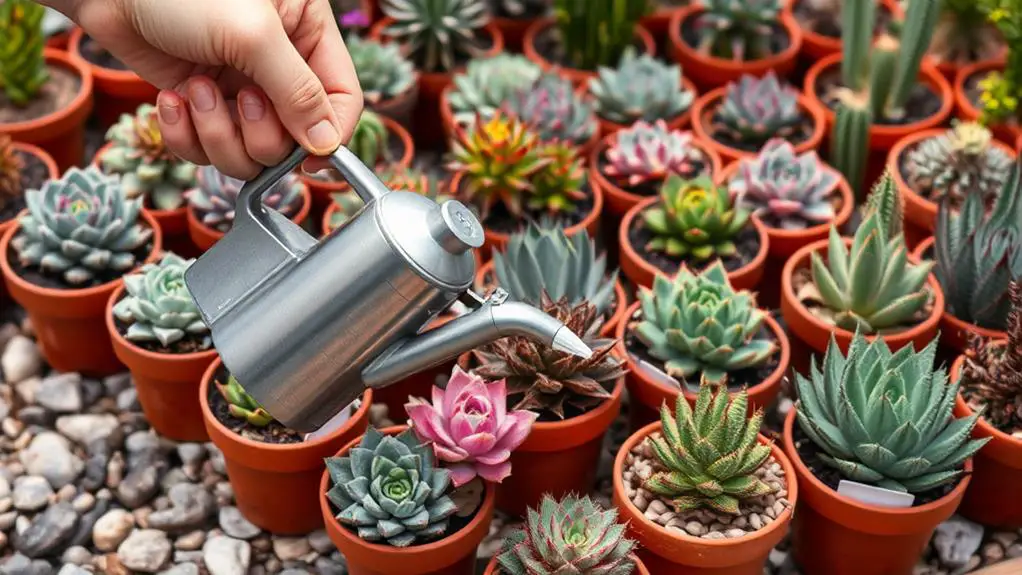
Watering practices play an important role in keeping your succulents healthy and vibrant. To master this, you'll need to understand how to balance moisture levels and guarantee proper drainage.
First, it's vital to use the "soak and dry" method. This means watering your succulents only when the top 1.25 inches of soil feels dry. Soaking the soil lets the roots absorb enough water, but make sure the pot has drainage holes to prevent root rot. Succulents don't like sitting in water.
Here are some key tips:
- Avoid overwatering: Signs include yellowing leaves or mushy stems.
- Adjust for seasonal changes: Water once a week in spring and summer, less in autumn and winter.
- Use room temperature water: It prevents plant shock and helps them thrive.
Always let excess water drain out of the pot. If you see water pooling at the bottom, it means your succulents might be at risk of overwatering.
Soil and Container Selection
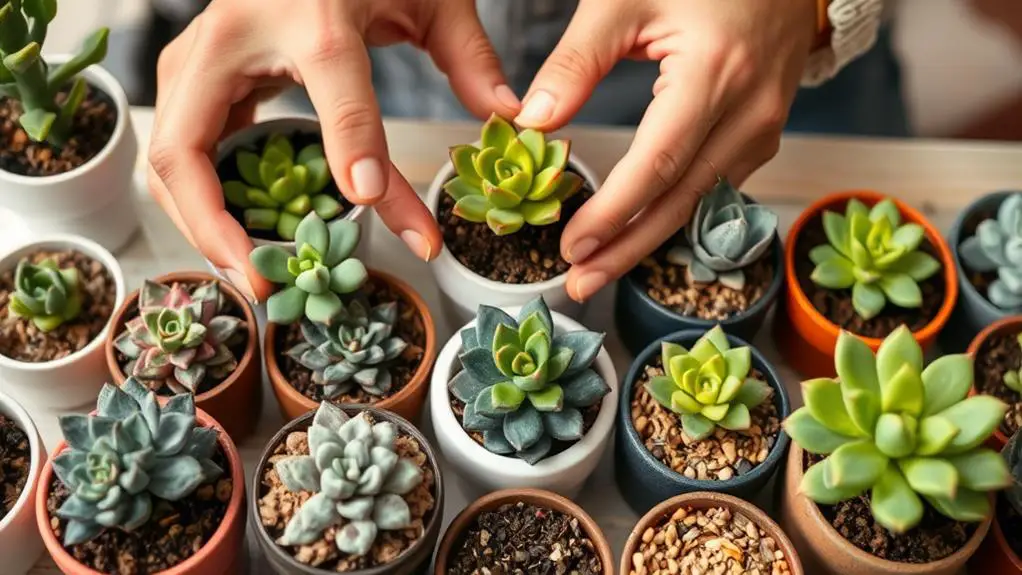
When choosing the right soil and container for succulents, it's crucial to prioritize excellent drainage. Using the correct soil guarantees your succulents stay healthy and avoid root rot. Regular potting soil isn't suitable because it retains too much moisture. Instead, opt for a well-draining soil mix specifically formulated for succulents.
You can also mix store-bought succulent soil with sand, pumice, or perlite. This creates a sandy, porous mixture that allows water to flow freely and provides excellent aeration.
Equally important is selecting the right container. Unglazed terracotta pots are ideal because they allow moisture to evaporate, which helps keep the soil dry. Make sure your container has drainage holes at the bottom. These holes let excess water escape, preventing waterlogging and promoting healthy root growth.
Avoid plastic pots, as they retain moisture and can lead to problems.
Remember to repot your succulents every 1-2 years. Fresh soil replenishes nutrients and keeps the growing medium ideal.
Frequently Asked Questions
What Are the Watering Instructions for Succulents?
Water succulents only when the soil feels dry. Use the "soak and dry" method, ensuring the soil dries completely between waterings. Adjust frequency based on seasons, and watch for signs of overwatering like yellowing leaves or mushy stems.
When Planting Succulents What Should You Avoid Because It Holds Water?
Avoid using regular potting soil because it holds water and can cause root rot. Instead, use a well-draining cactus mix or create your own by combining potting soil with sand, pumice, or perlite for better drainage.
How Do You Save a Succulent Over Water?
To save an overwatered succulent, take it out of the pot and shake off the soil. Trim any rotted roots and let the plant dry for several days. Repot in fresh, well-draining soil and water sparingly.
How Do Succulents Save Water?
Succulents save water by storing it in specialized tissues, opening stomata at night to reduce daytime water loss, and creating a microclimate when grouped together. Their resilience to extreme temperatures also helps them thrive with minimal irrigation.
Conclusion
Growing succulents is a fun and easy way to create a lovely garden while saving water. Remember to choose the right soil and containers, provide the right amount of light, and only water when needed. By following these simple steps, you'll have a thriving succulent garden in no time. Don't be afraid to experiment and learn as you go. You've got this, and your garden will thank you with its beauty and resilience!

